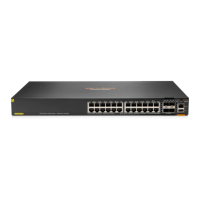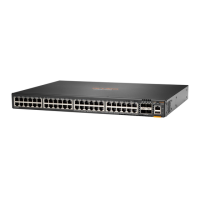74
Loadsharing Type: NonS
Management VLANs: None
System ID: 0x8000, 000f-e267-6c6a
Local:
Port Status Priority Index Oper-Key Flag
XGE1/0/1 S 32768 11 1 {ACDEF}
XGE1/0/2 S 32768 12 1 {ACDEF}
XGE1/0/3 S 32768 13 1 {ACDEF}
Remote:
Actor Priority Index Oper-Key SystemID Flag
XGE1/0/1 32768 81 1 0x8000, 000f-e267-57ad {ACDEF}
XGE1/0/2 32768 81 1 0x8000, 000f-e267-57ad {ACDEF}
XGE1/0/3 32768 81 1 0x8000, 000f-e267-57ad {ACDEF}
The output shows that link aggregation group 1 is a Layer 3 dynamic aggregation group that contains
three Selected ports.
Layer 3 aggregation load sharing configuration example
Network requirements
On the network shown in Figure 19, perform the following tasks:
• Configure Layer 3 static aggregation groups 1 and 2 on Device A and Device B, respectively.
• Configure IP addresses and subnet masks for the corresponding Layer 3 aggregate interfaces.
• Configure link aggregation group 1 to load share packets based on source IP addresses.
• Configure link aggregation group 2 to load share packets based on destination IP addresses.
Figure 19 Network diagram
Configuration procedure
1. Configure Device A:
# Create Layer 3 aggregate interface Route-Aggregation 1.
<DeviceA> system-view
[DeviceA] interface route-aggregation 1
# Configure Layer 3 aggregation group 1 to load share packets based on source IP addresses.
[DeviceA-Route-Aggregation1] link-aggregation load-sharing mode source-ip
# Configure an IP address and subnet mask for Layer 3 aggregate interface Route-Aggregation
1.
[DeviceA-Route-Aggregation1] ip address 192.168.1.1 24
[DeviceA-Route-Aggregation1] quit
# Assign Layer 3 Ethernet interfaces Ten-GigabitEthernet 1/0/1 and Ten-GigabitEthernet 1/0/2
to aggregation group 1.
[DeviceA] interface ten-gigabitethernet 1/0/1
[DeviceA-Ten-GigabitEthernet1/0/1] port link-aggregation group 1

